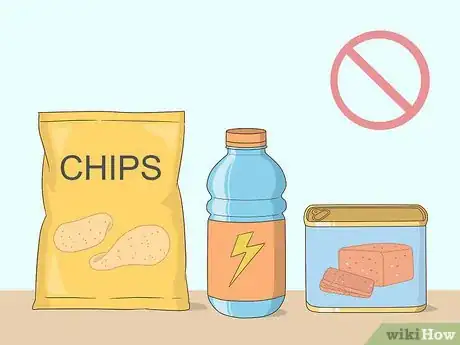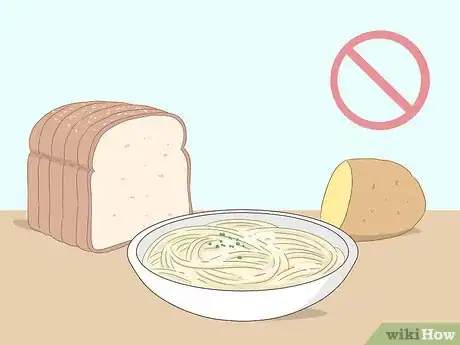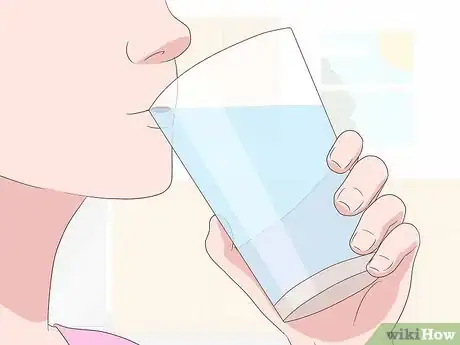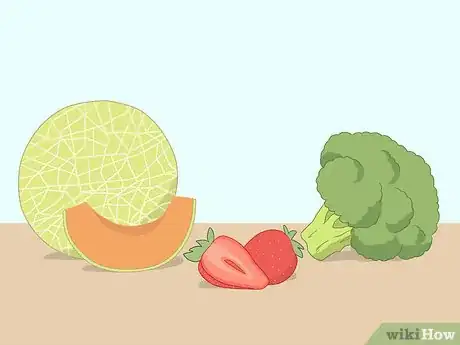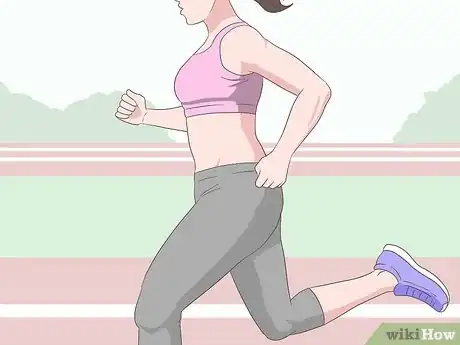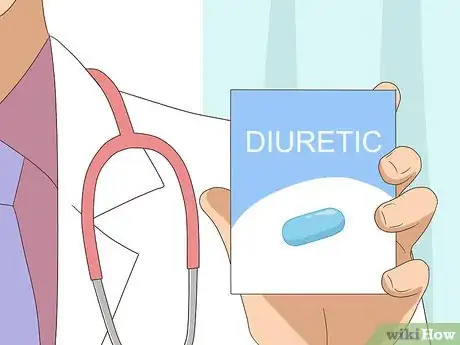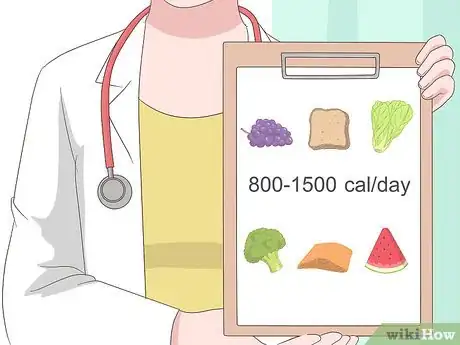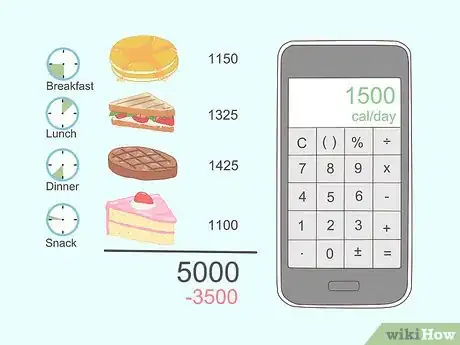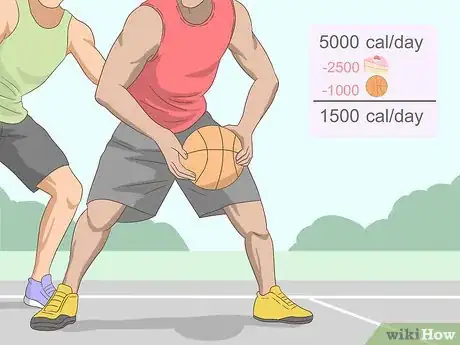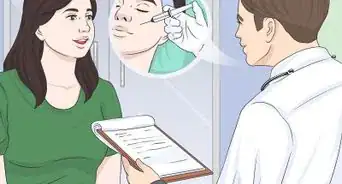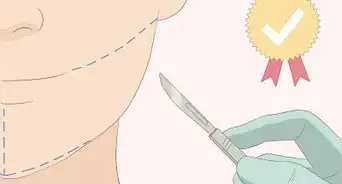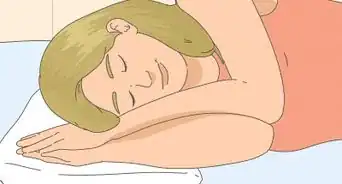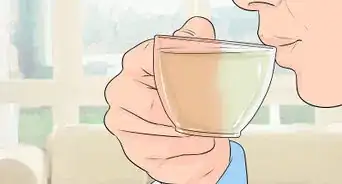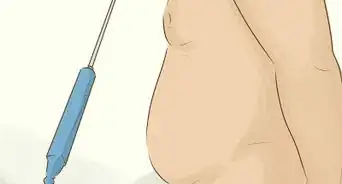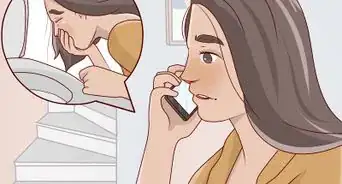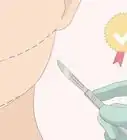This article was co-authored by Julian Arana, M.S.eD., NCSF-CPT and by wikiHow staff writer, Megaera Lorenz, PhD. Julian Arana is a Personal Trainer and the Founder of B-Fit Training Studios, a personal training and wellness set of studios based in Miami, Florida. Julian has over 12 years of personal training and coaching experience. He is a certified personal trainer (CPT) by the National Council on Strength and Fitness (NCSF). He has a BS in Exercise Physiology from Florida International University and an MS in Exercise Physiology specializing in strength and conditioning from the University of Miami.
There are 12 references cited in this article, which can be found at the bottom of the page.
wikiHow marks an article as reader-approved once it receives enough positive feedback. This article received 17 testimonials and 85% of readers who voted found it helpful, earning it our reader-approved status.
This article has been viewed 1,627,586 times.
Losing weight can be a long, frustrating process. In order to lose weight in a healthy way, most doctors recommend losing no more than 1–2 pounds (0.45–0.91 kg) in a week.[1] However, if you absolutely must shed a few pounds in a few days, you may be able to take off about 1 pound (0.45 kg) of water weight daily by cutting back on sodium and carbs and drinking more water. While you can lose a significant amount of weight that way over the course of a few weeks, the loss will slow down as your water weight stabilizes. If you want to burn a significant amount of fat in a short time, talk to your doctor about going on a limited-calorie diet for a few days.
Steps
Shedding Water Weight Fast
-
1Limit your sodium intake to minimize water retention. Eating too much salt can cause your body to retain water, adding unwanted pounds and making you feel bloated. To lose water weight, resist the urge to add salt to your food. Cut back on high-sodium foods and beverages such as processed meats, salted snack foods like chips and nuts, and sports drinks.[2]
- You can avoid many hidden sources of sodium by cooking your own meals from fresh, unprocessed ingredients.
- When you cook, try replacing salt with other flavorful seasonings, like black pepper or garlic.
- Eating more potassium-rich foods, like bananas, tomatoes, and sweet potatoes, can also help you flush excess salt out of your body.
-
2Cut back on carbs to shed water weight fast. Eating a lot of simple carbohydrates causes you to retain more water. This is the reason that many people experience rapid weight loss when they first switch to a low-carb diet.[3] To quickly shed water weight, try cutting back on high-carb snacks like white bread and pasta, baked goods, and potatoes.
- Try replacing high-carb foods in your diet with fruits and vegetables that are high in fiber, like berries, beans, and leafy greens.
- Going on a very low or no-carb diet for more than a few months can be bad for your health. Talk to your doctor about safe ways to adjust your carbohydrate intake.[4]
Warning: While cutting carbs out of your diet can help you lose weight in the short term, extreme low-carb diets aren’t recommended for long-term weight loss. A healthy diet should include complex carbohydrates, like whole wheat bread and brown rice.
Advertisement -
3Drink more water to flush excess fluids out. It may seem counterintuitive, but staying hydrated will make your body less likely to hold onto excess fluids. Most adults should drink 8–10 cups (1.9–2.4 L) of water per day in order to stay healthy and hydrated and prevent fluid retention. However, you will likely need to drink even more water if:[5]
- You exercise a lot
- You’re in a hot environment
- You’re pregnant or nursing
- You’re sick, especially if you have vomiting or diarrhea
- You’re on a high-fiber or high-protein diet
-
4Eat hydrating foods to get more water. Water isn’t the only good source of hydration for your body. You can also help flush out excess fluids by eating water-rich fruits and vegetables, such as melons, strawberries, and leafy greens.[6]
- Low-sodium soups or broths are also good options.
-
5Get some exercise to break a sweat. Exercising can flush excess fluid and sodium out of your body, helping you lose water weight quickly. Break a sweat by doing some cardio, such as biking, running, or brisk walking.[7]
- High-intensity workouts, like circuit training, are a great way to get rid of excess fluid and sodium.
- Just make sure to drink plenty of water during workouts. If you get dehydrated, you’ll end up retaining more water!
-
6Talk to your doctor about using diuretic medications. If you tend to retain a lot of fluid or gain water weight easily, talk to your doctor. They can help you figure out the source of the problem and treat it appropriately. Depending on how much water you’re retaining and what’s causing it, they may recommend medications or supplements to help you shed the excess fluids and water weight.[8]
- Common treatments for fluid retention include magnesium supplements and diuretics (“water pills”).
- If you gain more than 2 pounds (0.91 kg) in a day or 4 pounds (1.8 kg) in a week, call your doctor right away. Other signs of excess water retention can include swelling in your hands or feet, shortness of breath, coughing, nausea, and feeling full after eating only a small amount.[9]
Burning Fat Quickly
-
1Ask your doctor if you can safely go on a low-calorie diet. In order to lose fat quickly, you need to significantly reduce the number of calories you consume in a day. Most low-calorie diets involve restricting your daily intake to no more than 800-1500 calories.[10] Before attempting a diet like this, talk to your doctor about how much you can safely restrict your daily calorie intake, and for how long.
- Eating such a small number of calories each day is unhealthy for most people, and won’t help you keep the weight off in the long term.
- Most doctors don’t recommend very low calorie diets (under 800 calories a day) unless you need to lose weight quickly for medical reasons (e.g., if you are preparing for a surgery or trying to manage a medical condition, such as diabetes).[12]
Warning: A low-calorie diet may be dangerous if you’re pregnant, breastfeeding, or have certain health conditions, such as an eating disorder or a nutrient deficiency.[11]
-
2Count your daily calories to find out how much you can cut. The number of calories you need to eat each day to maintain your weight varies based on your age, sex, and activity level. On average, most adult women are supposed to get about 2,000 calories a day, while the recommended amount for men is about 2,500. You may be eating more than you think, however—for example, the average American adult eats about 3,600 calories a day. Before you start cutting calories, write down everything you normally eat in a day and add up the total number of calories.[13]
- You can find calorie information for pre-packaged foods on the package, and calorie counts are also available on many restaurant menus. You can also use a website like this one to find the calorie contents of most foods: https://ndb.nal.usda.gov/data-documentation.html.
- If you eat 3,600 calories a day, you would need to cut 2,100 calories per day to achieve a 1,500-calorie daily diet. However, be aware that this is not enough for you to lose a full 1 pound (0.45 kg) of fat per day.
- In order to lose 1 pound (0.45 kg) of fat in a day, you’d need to eliminate 3,500 calories from your daily diet. For most people, this isn’t possible to do safely unless you’re already eating an extremely high-calorie diet (about 5,000 calories a day).
-
3Burn extra calories with cardio exercise.[14] In addition to dropping calories by eating less, you can also burn calories by getting more physical activity.[15] For example, if you currently eat a very high-calorie diet of 5,000 calories a day, you could drop 3,500 calories by cutting 2,500 calories from your daily diet and exercising enough to burn 1,000 calories a day.
- The number of calories you can burn with exercise depends on a lot of factors, like your current weight. For example, if you weigh 185 pounds (84 kg), you can burn about 1000 calories by playing basketball for 2 hours. If you weigh 155 pounds (70 kg), you’d have to play for closer to 2.5 hours.[16]
- To find out how many calories you can burn with common forms of exercise, use a chart like the one available here: https://www.calculator.net/calorie-calculator.html.
- Keep in mind that if you’re consuming very few calories, you may not have the energy to safely do a lot of exercise.
-
4Plan to follow this diet for no longer than your doctor recommends. Going on a low-calorie diet isn’t a safe or effective long-term weight loss solution. If you really feel the need to lose 1 pound (0.45 kg) of fat per day, don’t try to do so for more than a few weeks at most. Your doctor can help you determine the best way to make the transition back to eating a healthy diet without rapidly regaining the weight you lost.[17]
- Keep in mind that you are likely to lose water weight and muscle mass as well as fat while on a very calorie-restricted diet.
References
- ↑ https://www.mayoclinic.org/healthy-lifestyle/weight-loss/in-depth/mayo-clinic-diet/art-20045460
- ↑ https://www.health.com/weight-loss/water-weight
- ↑ https://www.betterhealth.vic.gov.au/health/HealthyLiving/weight-loss-and-carbohydrates
- ↑ https://www.rush.edu/health-wellness/discover-health/skinny-low-carb-diets
- ↑ https://www.betterhealth.vic.gov.au/health/healthyliving/water-a-vital-nutrient
- ↑ https://www.health.com/weight-loss/water-weight
- ↑ https://www.health.com/weight-loss/water-weight
- ↑ https://www.mayoclinic.org/healthy-lifestyle/womens-health/in-depth/water-retention/art-20044983
- ↑ https://www.health.harvard.edu/heart-health/fluid-retention-what-it-can-mean-for-your-heart
- ↑ https://health.usnews.com/wellness/food/articles/low-calorie-diets-a-basic-guide
- ↑ https://www.nhs.uk/live-well/healthy-weight/very-low-calorie-diets/
- ↑ https://www.nhs.uk/live-well/healthy-weight/very-low-calorie-diets/
- ↑ Julian Arana, M.S.eD., NCSF-CPT. Certified Personal Trainer. Expert Interview. 19 March 2020.
- ↑ Julian Arana, M.S.eD., NCSF-CPT. Certified Personal Trainer. Expert Interview. 19 March 2020.
- ↑ https://www.mayoclinic.org/healthy-lifestyle/weight-loss/in-depth/calories/art-20048065
- ↑ https://www.calculator.net/calorie-calculator.html
- ↑ https://health.usnews.com/wellness/food/articles/low-calorie-diets-a-basic-guide
About This Article
Losing a pound a day is a very difficult goal for most people to meet, but you might be able to shed a few pounds in a few days if you focus on losing water weight. Stay away from foods and drinks that are high in sodium, like salty snack foods, processed meats, and sports drinks, since these will cause you to retain water. You can also shed some water weight fast by cutting back on carbs for a few days. The more you drink, the less water you’ll retain, so drink plenty of water and eat foods that are hydrating, like low-salt broths and juicy fruits and vegetables. Try to exercise and break a sweat, since exercise can help you both shed water and burn fat. Most doctors don’t recommend trying to lose more than 1 to 2 pounds in a week, so talk to your doctor about what’s safe for you before trying any extreme diet or exercise programs. For more tips, including how to burn fat fast with a limited-calorie diet approved by your doctor, keep reading!
